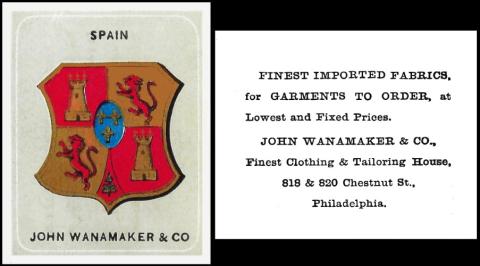
This card gives us two links to our theme.
The first of these was the issuer of this card, Wanamakers, which was a department store in America, simply because the first two questions in the basic numeracy test revolve around shopping. Level one of these is whether the candidate can add up a list of numbers, and tell which of four dated items is the oldest. Whilst level two adds in multiplication and percentages, and working out how many items come in a box when one end is left open.
The second was the shield, for Spain, which is currently twenty-third and lowest in the chart of worldwide numeracy. However America is twenty-first, and England seventeenth.
The problem with any kind of test is that it depends on whether everyone is included; there are some places which would probably have not included females. And not all the countries were included, none from Africa, where numeracy, and literacy, can be dependent on something we take for granted, simply being able to go to school. Yet in 2022 Kenya, Tanzania, and Swaziland topped the African numeracy charts. It would be interesting indeed to have those figures, and to find out where they fitted in to our list.
John Wanamaker first opened a shop in 1861 in Philadelphia, selling mens clothing. His brother in law ran it with him, but died in 1868. The store remained, and was very profitable, but John Wanmamaker had dreams of being the biggest retailer in the world, and he knew he would not get there just by selling clothes. Then two lucky coincidences came along; the Pennyslvania Railroad station came up for sale, just before the American Centennial Exposition opened. John Wanamaker`s idea was to cater to all these people, who would not have time to shop around, by offering a range of very different goods under one single roof. One of his first brilliant ideas was simply to save the staff having to remember the price of everything, whatever part of the store it came from, when it reached the tills - and what he did was to attach a small tag to every item, with the price on it, becoming the first shop to do such a thing.
They were also very quick off the mark at printing advertising cards. And they were the first to have an in store restaurant.
Just after the turn of the Twentieth Century they had the flagship in Philadelphia and two stores in New York. By the end of the century there were sixteen stores.
Then, in the 1980s the stores were bought by a Mr. Taubman. He went bankrupt in 1994, and the stores were split up between two rival chains, May and Penney.
There are actually two kinds of cards in this so-called series, there are flags, which are lengthways along the card and generally slightly darker, and shields, like ours which are upright. Note that they only advertise the clothing store, so they must be early - whilst any cards that mention the Grand Depot can be dated to after 1876.
